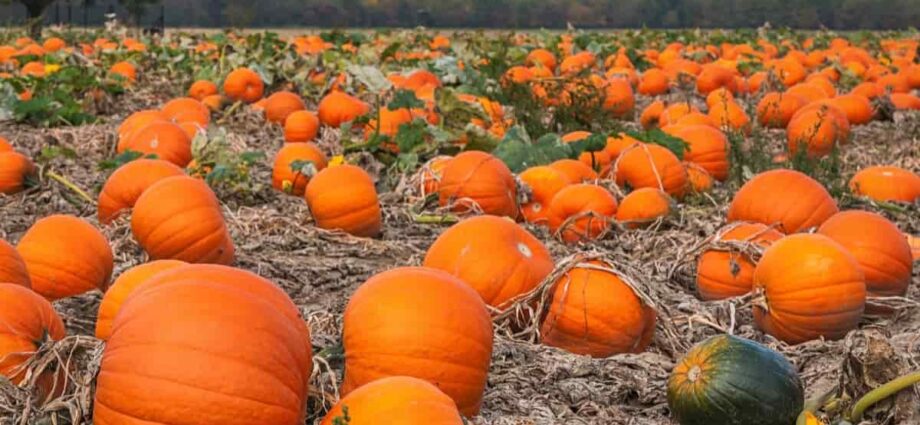Pumpkin is cultivated as a vegetable crop. Its plants emerge in the form of vines. In some of its varieties, fruits are found 1 to 2 metres long and a layer of light white powder is visible on the fruits. Moreover, raw pumpkin fruits are used as vegetables, and the ripe ones are used to make sweets in India.
Requirements In Pumpkin Cultivation
Suitable Soil And Climate In Pumpkin Cultivation
Pumpkins can be grown on any type of fertile soil. However, loamy soil is considered the most suitable for its good yield. Along with this, it can be easily cultivated in a field with proper drainage. For pumpkin cultivation, the pH value of the soil should be between 6 to 8.
Pumpkin cultivation requires a tropical climate for proper growth. Summer and rainy seasons are most suitable for its production, but the colder climate is not ideal for its cultivation. This is because its plant does not develop properly in cold weather. The pumpkin plants grow well at normal temperatures after transplanting, and seeds germinate well at temperatures up to 15 degrees. After the germination of seeds, a 30 to 40-degree temperature is required for the development of the plant. Pumpkins are not able to develop properly when the temperature is high.
Field Preparation For Pumpkin Cultivation
To cultivate Pumpkin, the field is first ploughed deeply 2 to 3 times with the help of a Trackstar tractor for efficiency. After ploughing, leave the field open for a few days, due to which the sunlight gets well in the soil of the area. Then after the first ploughing of the field, put 12 to 15 tonnes of old rotten cow dung manure in it as natural manure. After putting the manure in the field, oblique ploughing is done two to three times, due to which the cow dung manure mixes properly in the field’s soil. After this, apply water to the field. When the field’s water dries completely, it is ploughed once again with the help of a rotavator, due to which the soil becomes friable.
Fertilizer Management In Pumpkin Field
If you want to apply chemical fertilisers in Pumpkin cultivation, you should give DAP at the rate of 80 kg per acre at the time of the last field ploughing. After this, 50 kg of nitrogen is to be given at the plant’s irrigation time.
Planting Season And Method Of Pumpkin Seeds
Pumpkins are planted directly as seeds. Before planting the seed, treat the seed with appropriate amounts of Thiram or Carbendazim. About 6 to 8 kg of seeds are required in one acre of field. These seeds are planted in the beds prepared in the area, and the seeds are planted at a space of 1 to 1½ feet and at a depth of 2 to 3 cm.
Summer and rainy seasons are ideal for transplanting Pumpkin seeds. Apart from this, seeds can also be planted from February to the middle of March. In hilly areas, its seeds can be sown even after March.
Irrigation In Pumpkin Cultivation
Pumpkin plants require moderate irrigation. If you have planted this crop in the rainy season, then initial irrigation of the plant is not needed. But if there is no sufficient rain, we should give the plants water. Along with this, if you have planted its seeds in the summer season, then its plants require more irrigation for growth. Therefore, make sure to water the plants twice a week in the summer season. This helps in the development of plants.
Weed Control In Pumpkin Plants
Pumpkin crop requires more weed control. This is because its plants develop in the form of a vine, so there is a hazard of many diseases in the plants. Diseases also affect its yield. To control the weeds naturally, weeding must be done after 20 to 25 days of sowing. It requires a maximum of 3 to 4 weedings with the help of an effective farming machine such as a Solis tractor because the Solis tractor price is reasonable.
Diseases In Pumpkin Plants And Their Prevention
Red beetle insect This bright red-coloured insect eats the leaves of the plant and sieves them. Due to this disease, its leaves are damaged, and the plants do not develop properly. To protect your crop from this pest while sowing, destroy the weeds from the field and plough the area properly. Mix Malathion at the rate of 20 to 25 kg per acre in the field and spray Carbaryl solution in the fields with it.
Harvesting And Production In Pumpkin Cultivation
Pumpkin fruits are harvested for two types of uses. If you want to harvest fruits to make vegetables, you can gather them when they are unripe, and ripe fruits are harvested to make various things. After harvesting the fruits, they are sent to the market for sale. About 400 to 500 quintals of Pumpkin are easily produced in one acre of land. Moreover, the price of Pumpkin is reasonably profitable in the market, due to which the farmers who cultivate it can easily earn Rs. 1 to 2 lakh from its one-time production.
Stay connected with us for more details about the cultivation of profitable crops.

